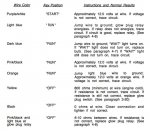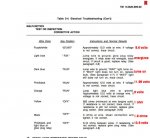wisconsinz
Member
- 52
- 1
- 8
- Location
- Duluth, MN
Hey guys,
I feel like I've done enough searching so I'm just gonna ask...
There are a few simple voltimeter actions listed in the instructions for testing the GPM that I don't grasp 100%. Does anyone mind elaborating on phrases like "Approximately 12.0 volts at wire","jump wire to ground","800 ohms at wire" (TM image is attached below). I'm assuming the first two use the voltage setting, and the last uses resistance, but where exactly am I placing my meter wires? thanks in advance.

I feel like I've done enough searching so I'm just gonna ask...
There are a few simple voltimeter actions listed in the instructions for testing the GPM that I don't grasp 100%. Does anyone mind elaborating on phrases like "Approximately 12.0 volts at wire","jump wire to ground","800 ohms at wire" (TM image is attached below). I'm assuming the first two use the voltage setting, and the last uses resistance, but where exactly am I placing my meter wires? thanks in advance.






